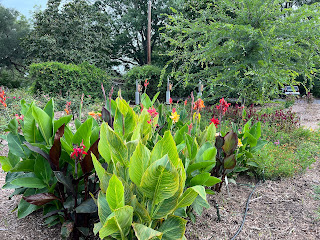 |
| Extension Agent Trevor Hylton shows us how to find stink bug damage on our tomatoes. Look at the size of that plant! |
Back to normal. Harvesting, weeding, admiring, comparing notes. Summer in the VegHeadz garden. An early start is important to get ahead of heat and humidity, but letting the dew dry is a good idea too. Touching plants while they are wet promotes transfer of funguses and bacteria—all too prevalent in our summer climate—from gloves and tools and from diseased plants to healthy ones.
Harvests have been abundant from the many tried and true and unique varieties grown in the garden this season.
This week we harvested Sugar Pie pumpkins, Chinese long beans, Aunt Molly's ground cherries, Honey and Cream corn, Purple Astronomy Domine corn, Early Prolific squash, cucumbers, wax beans, filet beans, Matt's Wild Cherry tomatoes, sweet yellow (Granex) bulbing onions, and Juliette roma tomatoes.
Wednesday was a pleasant and cool morning in the garden. Peggy was greeted as she arrived by a single red fox with a white tipped tail enjoying the quiet and the lush greenery in the garden.
 |
| Library seeds—watermelon, cukes and beans |
 |
| Chinese long beans—Bed D |
 |
| Companion planting—Nasturtiums and tomatoes—Bed C |
 |
| Gaillardia, Sweet William and Celosia |
 |
| Early Prolific Squash, zucchini, Sugar Pie pumpkins, and cucumbers along with Gaillardia—Bed A |
 |
| Three Sisters—Corn with Kentucky Wonder beans planted at the base and climbing the stalks, and winter squash vines covering the ground around them—Bed B |
As early vegetables fade, it’s a good time to plant summer vegetables and cover crops to continue supporting soil microorganisms, deter weeds, and provide a fall harvest. Linda planted okra seeds and sweet potato slips in the D beds today. These are both great choices for summer. They are undeterred by our heat and humidity and supply vegetables to eat when other crops are gone or not yet producing. Field peas of most any variety are also excellent summer cover crops which provide a harvest and supply nitrogen for fall crops.
The blueberries were weeded using chop and drop. This is a good technique when you chop them before they produce seeds. They can decompose in place without adding to next year’s weed problem. The best weeding technique is to hoe weekly while weeds are small and immature. It doesn’t take long.
The nut sedge grass was removed from the allium bed of perennial garlic and shallots. All the bulbing onions growing in several locations were harvested.
We have baby watermelons growing in two locations. The bitter melon gourd has reseeded around the forest garden trellis and is starting to weave its way up. So is the four year old chayote vine climbing the sunburst trellis. The chayote roots survived the hard freeze last winter and it’s exciting to see them climbing again. This plant will also survive summer weather just fine and provide a tasty harvest in late summer and fall.
We can’t fail to mention the Corsican decorative gourds growing up the (refurbished) old arbor, they are 10 feet long and are to the top already.
We have baby watermelons growing in two locations. The bitter melon gourd has reseeded around the forest garden trellis and is starting to weave its way up. So is the four year old chayote vine climbing the sunburst trellis. The chayote roots survived the hard freeze last winter and it’s exciting to see them climbing again. This plant will also survive summer weather just fine and provide a tasty harvest in late summer and fall.
 |
| Chayote vine returning after a hard freeze with chives growing below |
Flowers are such an important part of gardening success to attract pollinators and other good bugs and to provide pleasure to gardeners! Flowers galore are thriving in the VegHeadz garden. From Mexican sunflowers, Sweet William and Zinnias to Canna lilies, so many are in bloom now.
 |
| Yarrow in the Hugelkultur bed |
 |
| Zinnias |
 |
| Cannas |
 |
| Sunflowers |
 |
| First Echibechia bloom. Each plant is different because they are planted from saved seeds. A cross between Rudbeckia and Echinacea. |
We can’t fail to mention the Corsican decorative gourds growing up the (refurbished) old arbor, they are 10 feet long and are to the top already.
 |
| Lagenaria siceraria hard-shelled Corsican decorative gourds. What fun to see how they turn out. |
Wednesdays in the garden continue with plenty to see, and do, and learn. Come join us.






No comments:
Post a Comment